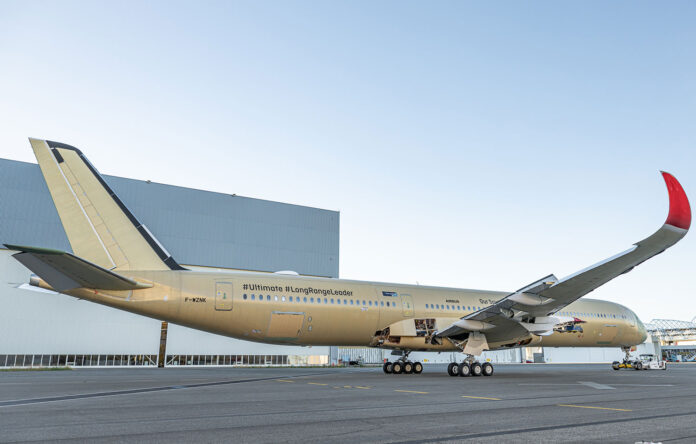Flying from Sydney to London in a single leap has been aviation’s white whale for decades. It’s a route so long that even the most advanced aircraft had to bow to fuel constraints (and the limits of human patience). Now, Qantas says it is almost ready to make that myth routine.
Its first Airbus A350-1000ULR, the flagship of the airline’s Project Sunrise program, has completed the major assembly stages in Toulouse, France. Wings, tail, and landing gear are on; the next stop is engine installation, instrumentation, and a gauntlet of test flights before delivery in late 2026. If all goes well, commercial passengers will board for non-stop journeys from Sydney to London and New York by early 2027.
For anyone who has dozed through a 14-hour flight and still had an eight-hour connection ahead, that’s a seismic shift.
This A350 is not your typical long hauler. Airbus re-engineered the design with an extra 20,000-liter rear-center fuel tank (essentially giving it a second stomach) to stretch its range to a staggering 22 hours of flight time. That means skipping the usual stopover in Singapore, Doha, or L.A.
The plane’s configuration is equally radical. Instead of squeezing in 350 seats like other A350-1000s, Qantas will install just 238. That’s less density than some private jets, a deliberate choice that trades economy seats for breathing room and a cabin tailored for human endurance. Note that this is not the first time airlines have promised to reduce passenger density, so we’ll have to test it for ourselves.
Between Premium Economy and Economy, passengers will find a “Wellbeing Zone”, a space for stretching, guided exercises, hydration stations, and mood lighting designed to trick your circadian rhythm into behaving. It sounds part yoga studio, part sci-fi spa.
Qantas worked with researchers at the University of Sydney’s Charles Perkins Centre to design everything from the lighting color to the timing of meals. The goal is not comfort for its own sake; it is actually about biology. The airline wants to blunt the body’s shock from flying through 10 time zones in one sitting.
The cabin layout, overseen by Australian designer David Caon, is infused with that same ethos: a mix of tactile calm and restrained futurism. Even the catering has been tested for its effects on sleep cycles and hydration.
The logic is simple: if you can keep passengers’ bodies on speaking terms with their brains during a 22-hour ordeal, you can charge a premium for it.

The Longest Game in the Sky
“Project Sunrise” borrows its name from Qantas’ wartime “Double Sunrise” flights of the 1940s, when Catalina flying boats connected Australia to the UK under radio silence. Those missions took more than 30 hours.
Today’s version is faster, safer, and far more profitable—but it carries the same national symbolism: conquering the “tyranny of distance” that has always isolated Australia from the world’s major markets.
The airline has ordered twelve A350-1000ULRs, betting that ultra-long-haul will be the next prestige frontier. The business case is straightforward: time is money. Shaving up to four hours off one-stop routes could tempt executives and high-spending travellers to bypass the Middle East entirely.
But there are challenges. Extended flights stretch crew-duty regulations, push maintenance schedules, and test passenger tolerance. And the aircraft itself had to clear additional certification hurdles because of its bespoke fuel system. So far, it has pushed delivery by nearly a year.
Ultra-long-haul travel has always been a delicate balance between human limits and technological bravado. Qantas’ gamble is that the next leap in aviation comfort will not come from faster planes but smarter environments that are tuned to physiology.
If the project succeeds, it could make a huge impact on global aviation. Hub-and-spoke models would lose some of their grip, and “non-stop to anywhere” could become the new premium benchmark.
Filed in . Read more about Airline and Travel.
